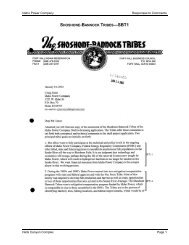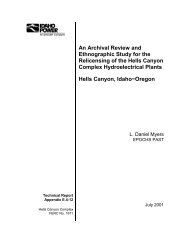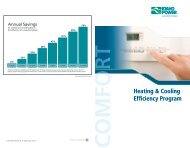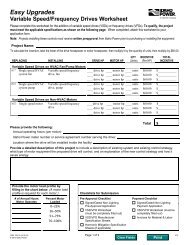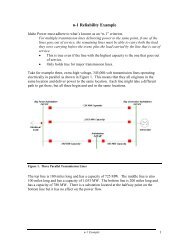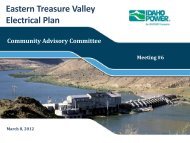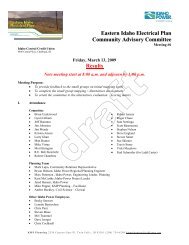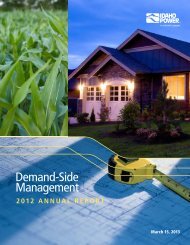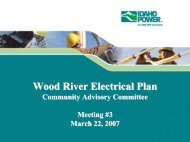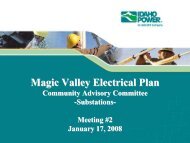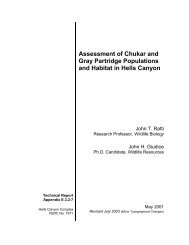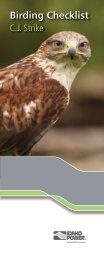Snake River White Sturgeon Conservation Plan ... - Idaho Power
Snake River White Sturgeon Conservation Plan ... - Idaho Power
Snake River White Sturgeon Conservation Plan ... - Idaho Power
Create successful ePaper yourself
Turn your PDF publications into a flip-book with our unique Google optimized e-Paper software.
<strong>Idaho</strong> <strong>Power</strong> CompanyChapter 4: Conceptual Design for <strong>White</strong> <strong>Sturgeon</strong> Passage Facilities4.2.4.2. Biological EffectivenessWe found no biological data for sturgeon using pressurized fish locks. Similarly, we found noinformation that helped us evaluate the design of a chute (for the biological effectiveness of fishlocks or fish lifts used as part of a pressurized passage system, see Sections 4.2.2.2. and 4.2.3.2.,respectively). Research is needed to prove the biological safety of this system. Of particularinterest is the reaction of sturgeon to changes in pressure, particularly when the surroundingwater is supersaturated with dissolved oxygen. The conclusions from such research woulddetermine the safe cycle time of a pressurized system. As with a fish lift or fish lock, theefficiency of the attraction system of a pressurized passage system would largely be determinedby the conditions at entrance to the facility.4.2.4.3. CostsBecause it is an untried system, we found no model of costs for a pressurized passage system.Additionally, because this system is experimental, there is significantly greater risk of costoverruns than for conventional methods of passing fish.4.2.5. Trap and Transport4.2.5.1. DescriptionA trap and transport facility collects migrating juvenile and adult fish above or below a dam,places them in transport vehicles, and releases them in the forebay or at another predeterminedlocation upstream of the dam.Trap and transport is a proven method that has been used for fisheries research and for gatheringbroodstock for sturgeon culture. A trap and transport facility can be designed as a separatefacility or adapted as part of a fish lift (described in Section 4.2.3.1.) (Figure 16). For example, ata lift facility (either before or after sorting), fish can be passed directly into the forebay, intoholding tanks for future movement, or directly into trucks for immediate transportation.Trap and transport systems have been used extensively to transport fish around both artificial andnatural obstructions. Sunset Falls Trap and Haul, located on the South Fork of theSkykomish <strong>River</strong> in western Washington and operated by the Washington Department of Fishand Wildlife, provides a successful example. That trap and transport facility began operating in1958 and passes migrating salmon past three natural falls. It was constructed to mitigate losthabitat in the lower Puget Sound system, and it opened up 90 mi of spawning and rearing areathat had previously been unavailable to salmon. It is currently used to transport up to 24,000 wildfish per year to the new, natural spawning areas. The Washington Department of Fish andWildlife had considered building fish ladders around the three falls, but has found that the trapand transport system is an effective and cost-efficient method of passing fish.For upstream passage, trapping needs to be based on the volitional drive of migrating sturgeon,including potential spawners or juvenile and nonreproductive fish that are sufficiently motivatedto move upstream and enter the trapping facility. Consequently, a holding structure with asuitably designed entrance and an attraction-flow system would need to be developed for thisHells Canyon Complex Page 21



